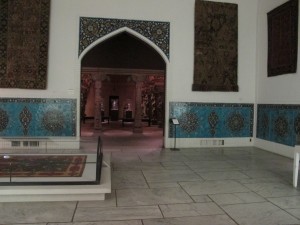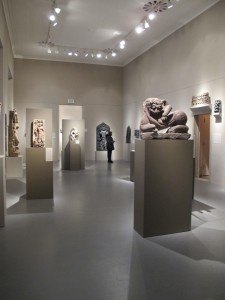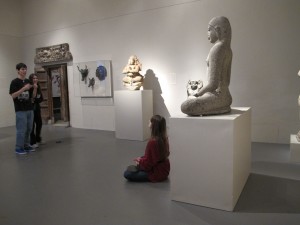Art, history, and interpretation: Gauging visitors' responses
22 August 2013 – Mekala Krishnan
 Read Part I of this series here.
Read Part I of this series here.
The first big step in the Philadelphia Museum of Art’s re-installation process was to conduct visitor research. How do visitors feel about the current South Asian galleries? What do they already know about the area’s religions, geography, cultures, etc.? What do they want to know? What do they find difficult or overwhelming? Which objects do they seem to be drawn to and why? These questions to laid the groundwork for the re-installation, and we set out to find the answers in a number of different ways.
We began by surveying the work done by other institutions with similar subject matter as many of the big museums here and abroad are undertaking similar projects, such as the Metropolitan Museum of Art which recently finished a very successful re-installation of their Islamic galleries. Many of these institutions carried out extensive visitor studies, and looking at their reports gave us an idea of the questions we wanted to ask and the methodologies we wanted to use. After sending out a request for proposals, we decided on a Boston-based research firm to conduct our study.
At the same time, we wanted to tap into the many resources available to us within the museum itself. Volunteer docents and staff educators spend their days in our galleries interacting with visitors, teaching, explaining and answering questions. Who better to ask if we wanted an idea of what the public felt about our galleries? I conducted extensive interviews with the twenty or so docents and educators who work regularly in the Asian art galleries. I wanted to get an idea of what was popular, what were common questions and misconceptions, the level of familiarity of most visitors, and importantly, what made visitors engage with artworks and get excited. It was an extremely fun process that gave us significant information, but also allowed us to mobilize a segment of the staff as a valuable resource.
 We also conducted an in-house tracking study as part of this process. Since the structure of the existing galleries is not going to be altered significantly in the re-installation, it was important to see how visitors navigate the space. The South Asian galleries are in the Asian wing of the museum, meaning that they share space with China, Japan, Korea, Southeast Asia and the Islamic world. With very minimal signage and no maps, this space can be confusing for visitors, and often it is hard for them to distinguish which country/culture they are looking at. The tracking study involved following visitors (unobtrusively!), noting the amount of time they spent in each gallery, and marking their path on a floor plan to get a sense of what draws them in and out of spaces, and which routes are most accessible.
We also conducted an in-house tracking study as part of this process. Since the structure of the existing galleries is not going to be altered significantly in the re-installation, it was important to see how visitors navigate the space. The South Asian galleries are in the Asian wing of the museum, meaning that they share space with China, Japan, Korea, Southeast Asia and the Islamic world. With very minimal signage and no maps, this space can be confusing for visitors, and often it is hard for them to distinguish which country/culture they are looking at. The tracking study involved following visitors (unobtrusively!), noting the amount of time they spent in each gallery, and marking their path on a floor plan to get a sense of what draws them in and out of spaces, and which routes are most accessible.
The most significant part of this entire process was the visitor study conducted by the outside firm. We chose the firm because they had unique methodologies focused on reaching our target audiences, and were open to having our department work with them to develop the study. The study consisted of two components: side-by-side interviews and engagement games. For each of these components, there were three target audiences we were looking at: visitors already in our galleries, visitors in the museum but not in our galleries, and people who were interested in arts and culture, but for one reason or another had not visited the museum recently. (This last group was selected through an interview process created by the firm in cooperation with a local recruitment facility, and visitors were provided with incentive to participate.)
The study took place over three days. Firm employees conducted the interviews and basically allowed visitors to explore the galleries as they usually would, while prompting them to think out loud, ask questions, and state opinions. We as museum staff followed quietly, took copious notes, and were able to see how visitors moved through the space, what they were interested in and drawn to, and what they felt about things like wall colors, lighting, labels, installation, flow and interpretation. Each side-by-side interview lasted about an hour.
 The engagement games allowed visitors to act as a curator: creating lists of top ten favorite, strange or fascinating objects, and/or choosing four objects and creating a story that linked them together. This really allowed us to see not only what people liked, but also how they were making connections and seeing relationships and narratives within the galleries. It was extremely fulfilling to see how excited visitors were and how long they were willing to talk with us! Currently the firm is working on putting together a final report to present us with their findings. I anticipate having plenty of food for thought leading into the next phase of the re-installation, which will involve creating a gallery plan and overall narrative, lists of objects to be displayed, and starting to think through various types of interpretive strategies for those objects.
The engagement games allowed visitors to act as a curator: creating lists of top ten favorite, strange or fascinating objects, and/or choosing four objects and creating a story that linked them together. This really allowed us to see not only what people liked, but also how they were making connections and seeing relationships and narratives within the galleries. It was extremely fulfilling to see how excited visitors were and how long they were willing to talk with us! Currently the firm is working on putting together a final report to present us with their findings. I anticipate having plenty of food for thought leading into the next phase of the re-installation, which will involve creating a gallery plan and overall narrative, lists of objects to be displayed, and starting to think through various types of interpretive strategies for those objects.
~ Mekala Krishnan is the E. Rhodes and Leona B. Carpenter Foundation Fellow in Indian and Himalayan Art at the Philadelphia Museum of Art.
All photos are by the author.



